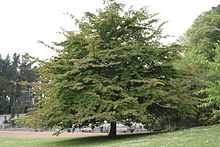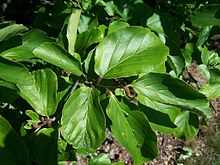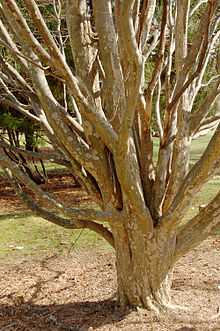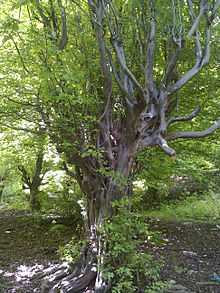Parrotia
| Persian ironwood | |
|---|---|
 | |
| Specimen planted in Belgium | |
| Scientific classification | |
| Kingdom: | Plantae |
| (unranked): | Angiosperms |
| (unranked): | Eudicots |
| (unranked): | Core eudicots |
| Order: | Saxifragales |
| Family: | Hamamelidaceae |
| Genus: | Parrotia C.A.Mey. |
| Species: | P. persica |
| Binomial name | |
| Parrotia persica (DC.) C.A.Mey. | |
Parrotia persica (commonly called Persian ironwood) is a deciduous tree in the family Hamamelidaceae, the sole species in the genus Parrotia but closely related to the witch-hazel genus Hamamelis. It is native to northern Iran and southern Azerbaijan (where it is called Dəmirağac) and it is endemic in the Alborz mountains.

Parrotia is named for the German naturalist Friedrich Parrot.[1]
Description
It grows to 30 m (98 ft) tall and 8–15 m (26–49 ft) broad, with a trunk up to 150 cm (59 in) in diameter. The bark is smooth, pinkish-brown flaking/peeling to leave cinnamon, pink, green, and pale yellow patches in a similar manner to plane trees. The leaves are alternate, ovoid, often slightly lop-sided, 6–15 cm (2–6 in) long and 4–10 cm (2–4 in) across, with wavy margins; they are glossy green, turning a rich purple to brilliant red in autumn.
The flowers are somewhat similar to witch-hazel flowers but dark red; they are likewise produced in late winter on bare stems, but differ in having only four rounded sepals with no petals; the stamens are however fairly conspicuous, forming a dense red cluster 3–4 mm (1⁄8–3⁄16 in) across. The fruit is a two-parted capsule containing two seeds, one in each half.[2]
The richness of Iran's flora and the variety of its vegetation results from the variety and richness of its physical-geographic and natural-historic conditions and from its compound history influenced by the remote florist regions.
Relict genera of the tertiary period can be frequently found in all the zones of North of Iran especially in Talysh. They are the Persian Iron tree (Parrotia persica), the Lenkoran acacia (Albizzia julibrissin), the basket oak (Quercus castaneifolia), the Caucasian persimmon (Diospyrus lotus), the evergreen shrub of Ruscus hyrcana, the box tree (Buxus hyrcana), etc. There are 240 endemic species of plants in North and North West of Iran and also south-east of Azerbaijan.

Cultivation
P. persica is cultivated as an ornamental tree for its stunning autumn colour and the smooth, patterned bark.[3]
Several cultivars have been selected for garden planting:
- 'Horizontalis': semi-weeping, wide-spreading horizontal branching pattern.
- 'Pendula' (Kew Form): Compact, weeping, quite graceful
- 'Select': Young leaves have purple margins, otherwise same as species
- 'Vanessa': Upright, columnar habit

Gallery
-

February Flowers, Muséum de Toulouse
-

September leaves
References
| Wikimedia Commons has media related to Parrotia persica. |